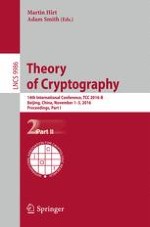2016 | OriginalPaper | Buchkapitel
Secure Obfuscation in a Weak Multilinear Map Model
verfasst von : Sanjam Garg, Eric Miles, Pratyay Mukherjee, Amit Sahai, Akshayaram Srinivasan, Mark Zhandry
Erschienen in: Theory of Cryptography
Verlag: Springer Berlin Heidelberg
Aktivieren Sie unsere intelligente Suche, um passende Fachinhalte oder Patente zu finden.
Wählen Sie Textabschnitte aus um mit Künstlicher Intelligenz passenden Patente zu finden. powered by
Markieren Sie Textabschnitte, um KI-gestützt weitere passende Inhalte zu finden. powered by
